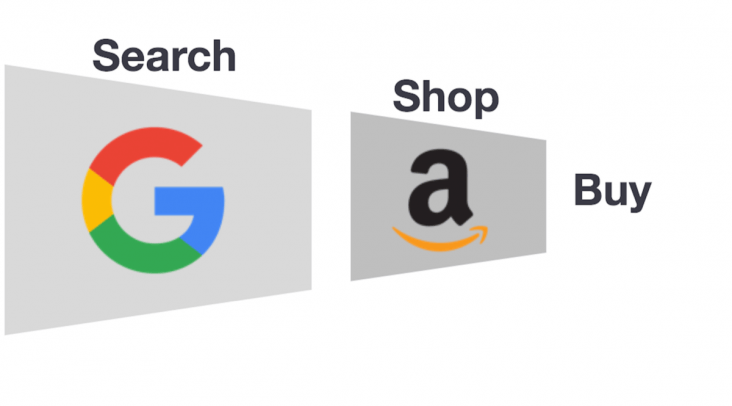Amazon, Google control much of the path to purchase for consumers
by September 25, 2019 7:05 pm 905 views

Courtesy: Jumpshot
Amazon and Google are the major players lined up in the path-to-purchase funnel, but retail experts say there is still an opportunity for others to grow market share in the booming e-commerce world.
During a recent webinar by marketing analytics firm Jumpshot, digital experts and analysts discussed the path to purchase for online commerce with Amazon at the bottom of the funnel and Google dominating search.
Steve Kraus, head of digital insights at Jumpshot, shared Amazon’s clear place at the front of the pack with 163 million digital transactions in August. He said the next 24 competitors, which include Walmart.com, eBay, Etsy and Target.com, had a combined of 64 million online transactions during the same month.
Kraus said Amazon is the undisputed leader, with eBay, Walmart.com, Etsy and Target.com rounding out the top five. He said Amazon’s customer focus has paid off with conversion rates at a high 8.3%. He said 54% of product searches originated on Amazon.com and not Google. Amazon also boasts it private brand sales rose 27% in the first quarter.
Kraus added that Amazon has become the master of utilitarian products and basics, dominating the path-to-purchase. That said, he outlined some opportunities for brands to gain traction in categories where Amazon is less dominant.
Jack O’Leary, a senior analyst with data insights business Edge by Ascential, said during the webinar that areas like women’s clothing, shoes, furniture and men’s clothing represent areas where Amazon has not yet gained control. He said Amazon has focused heavily on apparel and furniture, but those categories are still up for grabs. He said baby, pets and beauty are significant categories for Amazon but they have not reached the dominant level of electronics, which Amazon controls about 80% of the online market.
Food, an area that Walmart has heavily invested, is still leaning toward Amazon with roughly 70% of the total digital transactions in the U.S., according to Jumpshot.
Walmart is mounting a reasonable threat in fresh and frozen grocery, according to O’Leary.
Walmart’s Steve Breen, group general manager for Walmart eCommerce, said in Bentonville this week the retail giant will have online grocery pickup in 3,100 stores by the end of this year. He said grocery delivery for online orders will be in 1,400 stores by year’s end. Breen said Walmart is happy with the traction it is getting with its online grocery business, with baskets averaging two times the sales of a normal store basket. He said fresh items were also in 85% of the online grocery baskets, which is a sign the retailer is doing a good job with these categories.
He also spoke about Walmart.com general merchandise business and said it is also growing, but the retailer has taken a more conservative approach to third-party marketplaces and is focusing more on quality items as opposed to quantity. Walmart has roughly 75 million items for sale on Walmart.com, which is a fraction of the 564 million items Amazon said it had to start 2019.
When asked when Walmart might get the blue app (general merchandise) and the orange app (online grocery) consolidated for a more seamless shopping experience, Breen said it was a very complicated task given the store inventory among 5,400 stores is not the same. He then said voice commerce in the future won’t care which app is used. A shopper will tell the device to order an item from Walmart. The device will know which app to access. The explanation eluded to the fact that Walmart might not be as close to consolidating the two sites as Walmart U.S. eCommerce CEO Marc Lore predicted would be done by the end of the year.
Kraus said aside from Walmart’s threat with fresh grocery, Amazon also has lost ground when brands like Energizer have mounted a challenge in batteries. He said Amazon had the largest online share of battery sales in September 2017, but Energizer invested in strategic marketing and climbed back to the top by January 2018. Despite Amazon’s cheaper private branded batteries, Energizer widened its lead over Amazon throughout 2018 and the first half of this year. He said Duracell and Panasonic have kept their market share constant during that same time, but those sales are roughly half of that of Amazon.
Kraus said the online pet category is now led by Chewy, which overtook Amazon in the fourth quarter of 2018. Kraus said in early 2017, Amazon sold two times more dog food than Chewy. Last month, Chewy dog food sales were on par with Amazon, after coming down in the first two quarters of 2019. Kraus said Amazon has lost dog food sales to Chewy but has retained dominance in pet toys, selling two times more than Chewy last month.
Kraus said Amazon sells 75% of transactions across categories. As much as Amazon dominates online sales, Google also is a major player in search with 90% of total search volume. That said, Amazon is the go-to for product search, garnering 54% of inquiries for products.
He said CPG searches skew toward Amazon and health searches skew toward Google. For instance, items like baby wipes, are more likely to begin on Amazon, where searches for tea tree oil are more likely to begin on Google.
Kraus said Google is also winning market share in categories Amazon is not focusing, such as travel. Google Hotel and Google Flights have become increasingly popular searches among more consumers. Google reports traffic for Google Hotel is up 74% in the past year.
O’Leary said Amazon has not dabbled in the financial services area, through Walmart has done so with Walmart Pay and money transfers done via the retailer’s mobile app. He said retailers like Walmart that try and differentiate their services can gain ground against Amazon.
